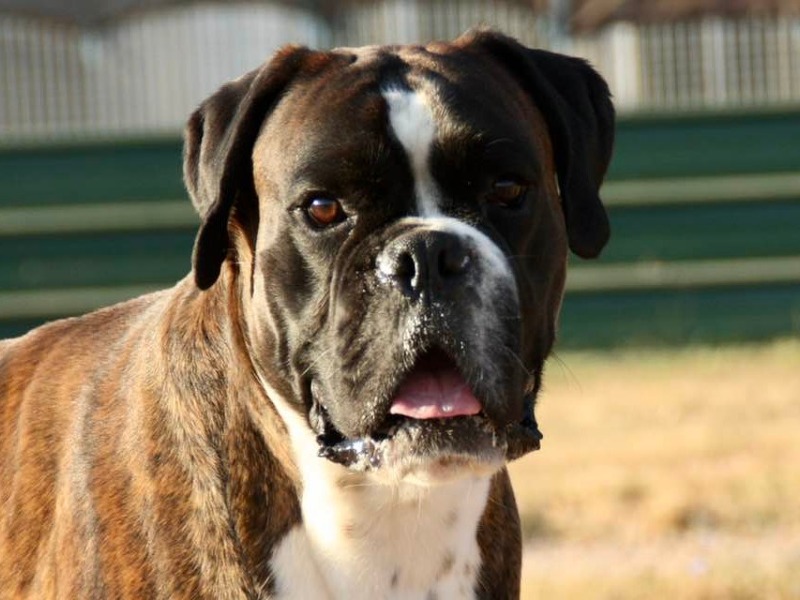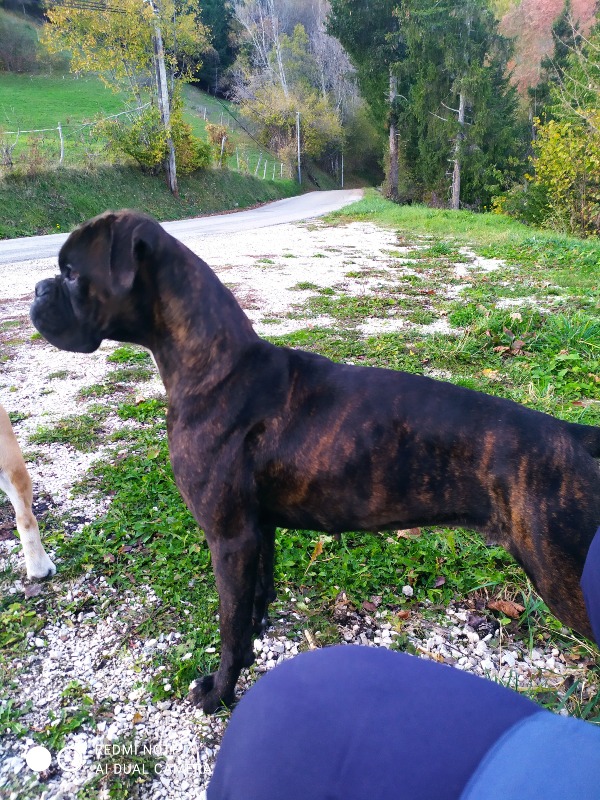Boxer
Welcome to our page dedicated to the breed of dog boxer!
Here, you will find all the useful information about boxer. This descriptive profile will allow you to discover the aspects of this breed. You can notably consult information about the average price, monthly and annual upkeep expenses, their health, name ideas, as well as their official recognition by competent authorities.
Explore this page to discover everything you need to know.
Overall description of the breed
The history of the Boxer dates back to 19th century Germany. The breed was developed by crossing English Bulldogs and Bullenbeissers, German hunting dogs used to catch game. Boxers were bred to be versatile dogs, capable of hunting, herding and being loyal companions. They quickly gained in popularity thanks to their energetic temperament and protective nature.
Boxers are distinguished by their muscular, compact build. Males average 27-32kg (60-70lbs), while females generally weigh 24-29kg (55-64lbs). In terms of height, males measure an average of 57 to 63 cm (22.5 to 25 inches) at the withers, while females measure around 53 to 59 cm (21 to 23 inches). These measurements may vary slightly depending on the individual.
The distinctive morphology of the Boxer includes a square, powerful head with a short muzzle and powerful jaw. The eyes are dark, expressive and lively. The ears, traditionally cropped, are medium-sized and carried erect. However, more and more countries have banned ear cropping for animal welfare reasons. The Boxer's tail is naturally short and set high.
The Boxer's character is one of its most appreciated features. They are cheerful, friendly dogs full of energy. They are known for their great affection for their family and their protective nature. Boxers are generally very tolerant of children and get on well with other pets. They are also renowned for their intelligence, obedience and ability to adapt to different situations.
As far as official recognition of the breed is concerned, the Boxer was founded by the Deutscher Boxer-Club e.V. in Germany. The breed standard was established in 1902, defining the desired characteristics and traits of the Boxer. The FCI officially recognised the Boxer on 01 January 1955. The breed is classified in group 2 - Pinscher and Schnauzer type dogs - Molossians - Swiss Mountain and Cattle Dogs. More specifically, the Boxer is listed in section 2.1 - Mastiff-type Molossoids.
In conclusion, the Boxer is a remarkably athletic breed with a playful, protective character. Its rich history dates back to the 19th century, and since then it has become one of the most popular companions in many homes around the world. With its muscular build and loving personality, the Boxer is not only a great companion dog, but also a competent working animal in a variety of fields. Whether as a family, guard or working dog, the Boxer brings joy, energy and devotion to all those lucky enough to have him by their side.
Awareness of acquiring an animal
Each animal is a sensitive being, deserving love, attention and care.
When you choose to adopt an animal, you take on the responsibility of ensuring its health and well-being throughout its life.
To learn more about animal welfare, we invite you to consult our FAQ by clicking the button below:
Origins
The Boxer finds its origins in Germany in the 19th century. It descends from the Bullenbeisser, an old hunting dog used to catch large game such as wild boars. The Bullenbeisser itself is the descendant of the ancient Asian mastiff breed. German breeders crossed these dogs with Bulldogs to create a more agile and versatile dog. The goal was to develop a breed that combines strength and intelligence while being an excellent family companion. This is how the Boxer was born, bringing together the qualities necessary to become a guard and working dog. In 1895, the first dog show where the Boxer was presented took place in Munich, marking the beginning of its popularity. Today, the Boxer is recognized worldwide for its various skills and balanced temperament.
History
The history of the Boxer is closely linked to that of the Bullenbeisser. In the late 19th century, German breeders worked to refine the breed by crossing these dogs with English Bulldogs. The first Boxer club was founded in 1895 in Munich, and the breed standard was established in 1902. During World War I, the Boxer was used by the military forces for its qualities as a guard dog, messenger, and search and rescue dog. After the war, the breed gained popularity, especially in Europe and the United States. Over the years, the Boxer has continued to demonstrate its abilities as a working dog, while remaining a devoted and affectionate family companion.
Standard
The Boxer breed standard is strictly defined by canine organizations. The Boxer must have a powerful and athletic appearance. The head should be well proportioned with a square muzzle and powerful jaws. The ears are traditionally cropped to stand straight, although this practice is becoming less common and often prohibited. The eyes are medium-sized, dark, and express intelligence and vigilance. The body is compact and muscular, with a deep chest and a straight topline. The tail is usually docked, but this practice is also increasingly controversial. The legs are strong and straight, allowing for a confident and elastic gait. The standard emphasizes a balanced structure that gives the Boxer its strength and agility.
Physical characteristics
The Boxer is a medium-sized dog, measuring between 53 to 63 cm at the withers for males and between 51 to 61 cm for females. The weight ranges from 25 to 32 kg for males and 23 to 29 kg for females. The coat is short, smooth, and tight to the body, offering minimal protection against the weather. Typical colors are fawn, ranging from light fawn to dark fawn, and brindle. Some white markings are accepted, but they should not cover more than one third of the body. Boxers can also have a black mask. Their well-developed musculature and robust bone structure give the Boxer an athletic and dynamic appearance.
Character
The Boxer is known for its cheerful and energetic character. It is a dog very attached to its family and particularly patient with children. Playful, it is always ready to participate in all kinds of activities, making it an excellent playmate. The Boxer is also an intelligent dog and very receptive to training. Its protective nature makes it a good guard dog, always vigilant and ready to defend its family. However, it can be wary of strangers and requires early socialization to prevent any aggressive behavior. Overall, the Boxer is an affectionate, loyal, and balanced dog, ideal for an active family life.
Life expectancy
The life expectancy of a Boxer is between 10 and 12 years. Just like with many dog breeds, this longevity can be influenced by various factors such as genetics, diet, medical care, and lifestyle. It is important to regularly monitor the health of the Boxer, especially its joints and heart, as certain hereditary diseases can affect this breed. A balanced diet, regular exercise, and frequent veterinary visits can help prolong your Boxer's life, ensuring a healthy and happy existence.
Exercise and activity needs
The Boxer is a very active breed that requires a lot of exercise to stay physically and mentally healthy. On average, at least one to one and a half hours of daily activity is needed. This can include walks, running sessions, interactive play, and mental stimulation activities. Boxers love to run and play, making them perfect for families who enjoy outdoor activities. Lack of exercise can lead to behavior problems such as boredom and destruction. Mental stimulation, such as puzzle games and training, is also essential to keep the Boxer's mind busy.
Recommended diet
A Boxer's diet should be balanced and adapted to its high energy needs. It is recommended to provide high quality food rich in proteins and healthy fats. On average, an adult Boxer consumes between 250 and 350 grams of kibble per day, divided into two meals. Monthly food costs can range between 50 and 100 euros, depending on the quality of the food and the specific needs of the dog. It is important to monitor its weight and ensure that it does not overeat to avoid obesity, which can lead to health problems.
Training and obedience
The Boxer is an intelligent and receptive dog, which makes it relatively easy to train. However, it can also be stubborn and requires consistent and patient training. Training should start at a young age with early socialization to prevent mistrust towards strangers and other animals. Using positive reinforcement methods, such as rewards and praise, is particularly effective with this breed. It is important to establish clear rules and to stay consistent in their application. Boxers enjoy mental and physical challenges, so incorporating games and exercises into the training program can be very beneficial.
Behavior with children
The Boxer is known for its gentle and patient nature with children. It is a protective and playful dog that enjoys interacting with younger family members. Its robustness and energy make it an excellent playmate. However, as with all dogs, it is essential to supervise the interactions between the Boxer and children to ensure that the play remains safe and appropriate. It is also crucial to teach children to respect the dog and understand its signals. Well-socialized and trained, the Boxer can become a true loyal and protective friend for children.
Compatibility with Other Animals
The Boxer can get along well with other pets if properly socialized from a young age. However, their protective instinct and high energy can sometimes pose challenges, especially with smaller or more timid animals. Early socialization and gradual, controlled introduction to other animals are essential to avoid aggressive or overly excitable behaviors. Boxers are generally friendly with other dogs, but conflicts can arise if not properly introduced. With proper training and supervision, a Boxer can harmoniously get along with most other pets.
Grooming needs
The Boxer has a short and smooth coat that requires little maintenance. A weekly brushing is sufficient to remove dead hairs and keep its coat in good condition. Boxers are relatively clean dogs and do not need frequent baths unless they are particularly dirty. It is important to regularly clean their ears to prevent infections and to trim their nails every month to avoid foot problems. Dental care is also crucial; brushing their teeth or giving them chew toys can help maintain good oral hygiene. In general, grooming a Boxer is simple and undemanding.
Health
Boxers are subject to certain specific health conditions, notably heart problems such as cardiomyopathy, cancers, and joint disorders such as hip dysplasia. They can also be sensitive to certain skin allergies. Owners must therefore be vigilant and conduct regular veterinary visits to quickly detect and treat any health issues. Monitoring their diet and weight is also crucial to prevent obesity. Screening tests for hereditary conditions are recommended before purchasing a Boxer puppy to ensure long-term health.
Average price
The price of a Boxer puppy can vary considerably depending on the breeder's reputation, the lineage of the parents, and the location. On average, the cost of a Boxer puppy ranges between 800 and 2000 euros. Puppies from champion bloodlines or with exceptional pedigrees can cost even more. It is crucial to buy from reputable breeders who conduct health tests on their dogs and breed in ethical conditions. A higher initial price can often result in reduced long-term health costs, thanks to better genetics and responsible breeding practices.
Expenses
The average monthly expenses for a Boxer can vary between 100 and 150 euros, depending on various factors such as food, veterinary care, pet insurance, and accessories. Food represents a significant portion of this budget, with costs ranging from 50 to 100 euros per month for high-quality food. Veterinary care, including vaccinations, deworming, and regular check-ups, can add around 20 to 50 euros per month. One must also consider costs for toys, accessories, and possibly training or boarding fees, which can increase the monthly budget.
Name ideas
For a Boxer, it is best to choose a short and easily recognizable name. Here are some suggestions: Rocky, Bella, Max, Luna, Tyson, Maya, Bruno, Daisy, Rex, Molly, Zeus, Ruby, Duke, Rosie, Apollo, Oscar, Zara, Bruno, Lola, Hugo, Mia, Leo, Bella, Scout, Finn. These names reflect the energetic character and robust appearance of this breed. It is important to choose a name that the dog can easily identify and that is easy to pronounce for all family members. A suitable name can facilitate training and strengthen the bond between the dog and its owner.
Legislation and regulation
The Boxer is generally not classified as a dangerous breed and is not subject to strict regulations in most countries. However, owners must comply with local laws regarding registration, vaccination, and dog ownership. In France, Boxers are not classified in category 1 or 2 of so-called dangerous dogs, which means they do not require a special permit. It is nevertheless advisable to check the specific laws of your region or country, as regulations may vary. Responsible ownership also includes respecting rules of behavior in public and ensuring that the dog does not pose a danger to others.
Official recognition
The Boxer is recognized by many canine organizations around the world. In France, it is recognized by the Société Centrale Canine (SCC). In the United States, the Boxer is registered with the American Kennel Club (AKC). In the United Kingdom, it is recognized by the Kennel Club (KC). The Fédération Cynologique Internationale (FCI) also recognizes the Boxer and has established the breed standard. These organizations oversee the breed standards, competitions, and pedigree registrations, thereby ensuring the purity and quality of the breed.
Pedigrees
Purebred Boxers can be registered with various breed clubs around the world. In France, the official organization is the Club des Amis du Boxer. In the United States, the main breed club is the American Boxer Club. In Great Britain, the Boxer Breed Council is the governing authority. In Germany, the Boxer-Klub e.V. is the main organization. These clubs provide resources and information on bloodlines, breed standards, and recognized breeders. They also organize events and dog shows, allowing owners and breeders to showcase their dogs and exchange knowledge.
Destination and usage
The Boxer is a versatile dog, used in various activities thanks to its strength, agility, and intelligence. Historically, it was used as a hunting dog for big game. Today, it is often used as a guard and protection dog due to its protective instinct. The Boxer also excels as a working dog in law enforcement and rescue services. Apart from these roles, it is an excellent companion dog, appreciated for its playful and affectionate nature. Its energy and motivation also make it suitable for canine sports such as agility and obedience.
Prohibitions
The Boxer, generally, is not subject to specific bans, unlike some breeds classified as dangerous. However, it is essential to respect local regulations related to dog ownership. Some jurisdictions may impose restrictions on holding dogs in public without a leash or muzzle. In addition, some residential areas or condominiums may have regulations regarding ownership of large dogs. It is crucial for owners to inquire about local laws and to ensure that their Boxer is well trained and socialized to avoid any potential issues with authorities or neighbors.
Breeders of Boxer
Want to see more breeders of Boxer?
Check out the page of our directory listing all breeders of BoxerClassified Ads of boxer
No of boxer classified ads are available on Preeders.
If you’re a breeder, sign up for free now and be the first to post a classified ad
Breed clubs of boxer
No of boxer breed clubs are currently registered on Preeders.
If you would like to highlight your breed club, sign up for free now and be the first to appear on this page.





